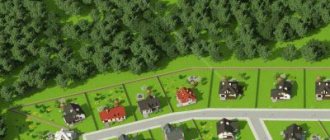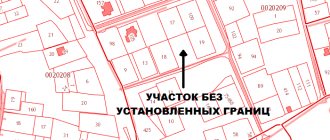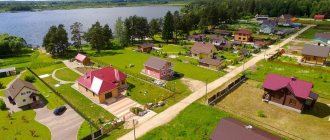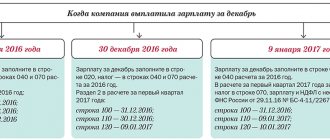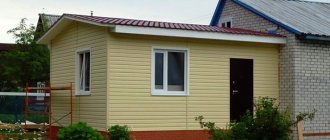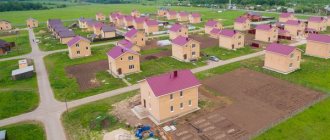The difference between private household plots and individual housing construction
former minor prisoners of concentration camps, ghettos, and other places of forced detention that were created by the invaders and their allies during the Second World War.
To receive benefits, you must complete the appropriate documents with the social protection authorities; 4. citizens who were exposed to radiation as a result of nuclear checks at the Semipalatinsk test site and received certain degrees of radiation, and their children of the first and second generations who have health problems due to the fact that their parents received a dose of radiation. They can receive benefits on the basis of a special ID and medical certificate;
Land plots
For this privilege, the plot must not be larger than 0.5 hectares. Also, the process of growing/processing products should be carried out by family members without the involvement of outside forces. The law on private household plots in 2021 states that private plots must be registered and must have a document indicating its size and type of products grown.
Is it possible to build a separate house on a private plot and what are the construction standards on a private plot? Such an opportunity depends on the district administration employees. They may legally prohibit the construction of a building or prohibit the laying of communications if the site is located behind a populated area or is not adjacent to it.
Legal educational program on the topic: is it possible to build a house on the lands of private household plots and what is needed for this?
- GPZU (urban planning plan of the site), is ordered from the MFC or from the architecture committee of the administration in whose department the land plot is located. The service is free. Time to receive 30 days.
- SPOZU (scheme of planning organization of a land plot). The diagram can be ordered from any specialized organization (for a fee, prices vary) or made by yourself.
- Certificate of ownership or other document for the land plot.
- applications for building permits
- applications for building permits
- Take an extract from the Unified State Register of Real Estate for the land plot, which should indicate the owner and classification of the land to which the private plot belongs.
- Obtain from the MFC or other authorized body the GPZU (urban planning plan for the land plot).
- Based on the GPZU, indicate the location of the constructed facility.
- Submit an application, house layout diagram and GPZU to the MFC or other municipal body to obtain a building permit.
- After receiving permission, order a technical plan from a cadastral engineer.
- Then submit all documents again to the MFC to receive an extract confirming ownership of the house.
What can be built on LPH lands?
The general characteristics of lands in this category are that they are located outside the boundaries of settlements and are intended for agricultural needs (clause 1 of Article 77 of the Land Code of the Russian Federation). However, the type of agricultural land use can vary greatly, limiting the owner’s ability to develop it.
There are also several options here. On some plots you can build a residential building for year-round use without any restrictions, register and live in it. On others, the construction of only a residential building is allowed, in which, for example, it is not possible to register. However, if certain conditions are met, it can also be recognized as residential and then registration will be allowed.
What can be built on the lands of private household plots and for the construction of which objects permission is required
The lands of private household plots located outside the boundaries of populated areas can be used not only for farming (gardening, horticulture, livestock breeding, etc.), but also for summer cottage construction. This means that the construction of any structures that are temporary in nature is permitted, i.e. erected without a permanent foundation - a foundation. Accordingly, permission for the construction of temporary structures is not required.
Legislatively, a private plot is intended for the owner of the land and members of his family to run an economy not related to entrepreneurial activity. On such land, a citizen can engage in the production of agricultural products, as well as their processing for personal consumption.
Private household plot: what is it and is it possible to build a house on it?
Federal Law No. 112-FZ gives the concept according to which personal subsidiary farming (LPH) is a form of activity that does not imply systematic income generation or entrepreneurship. A citizen and his family have the right to own a plot of land, produce and process agricultural products from it for personal purposes and needs.
Another procedure is when the site belongs to a municipal or state fund. It can be found independently in the category of lands that are not used. Such information is publicly available. The public cadastral map on the Rosreestr website will help in the search. For each site of interest, here you can see not only the category of permitted use, but also brief characteristics.
Is it possible to build a house on a plot for private plots?
- application for a building permit;
- a document confirming the existence of property rights to the site - an extract from the Unified State Register of Real Estate, a certificate of ownership, etc.;
- urban planning scheme of the land plot;
- a schematic representation of the site layout indicating the location of the future building;
- a detailed description of the appearance of the future residential building, if the territory is historically significant.
This trend can be seen in relation to private household plots located within the boundaries of a populated area. For “field” areas, restrictions still apply, because such land is recognized as agricultural. So, according to the law, the construction of a residential building on them is not allowed. The intended purpose of such territories is agricultural production without development rights.
We recommend reading: Recognition of Property Rights Due to Acquisitive Prescription
Construction on a land plot of individual housing construction: basic standards
Existing construction standards on individual housing construction land plots in 2019 remained unchanged. This means that landowners still need to comply with them. Otherwise, the relevant government agencies will not allow you to legitimize real estate properties and obtain ownership rights to them.
If the area of the site itself does not exceed 1 km 200 m, then urban planning regulations allow the construction of only one residential building. As for the “red line”, it should be understood as public places (roads, neighboring areas, etc.). According to the rules, when constructing residential buildings and other buildings on the site, it is important to maintain the established distances: 5 m from the road and 3 m from the driveway.
We recommend reading: Will: pros and cons
Is it possible to build a residential building on a private plot without obtaining a building permit?
Andrey, start by clarifying the permitted use of the land plot (see the cadastral passport for the land plot). According to Article 4 of the Federal Law “On Personal Subsistence Farming”, plots of private household plots are divided into two types: homestead and field. A plot of land is used for the production of agricultural products, as well as for the construction of a residential building, industrial, domestic and other buildings, structures, structures in compliance with urban planning regulations, construction, environmental, sanitary and hygienic, fire safety and other rules and regulations. A field plot of land is used exclusively for the production of agricultural products without the right to erect buildings and structures on it. If your land plot is located within the boundaries of a populated area, i.e. is a personal property, you can plan to build a residential building; if the land plot is located outside the populated area, i.e. field, it is impossible to build a residential building, its construction may end with a court decision on the demolition of the unauthorized building at the request of interested parties.
3. What to do if you started construction without obtaining a permit or urban plan, but before the end of the amnesty (until 2015) did not manage to bring the construction to the stage of registration (registration) of the house, can in this case insurmountable difficulties arise in the legal registration of the building , or if I’m not sure that I’ll be able to do it before 2015, then it’s better not to start construction without the appropriate documents?
Construction standards for individual housing construction and private plots
The concept of “individual residential building”, in accordance with Part 3 of Art. 48, clause 1, part 2, art. 49 of the Town Planning Code, applies to all individual residential buildings, regardless of the permitted use of the land plots on which such houses are located and the type of territorial zone. An individual residential building is considered to be a single-apartment building, i.e. a detached residential building with no more than 3 (three) floors, intended for one family (clause 2, clause 1 of Article 51 of the Town Planning Code of the Russian Federation). Let's also assume a fourth, attic floor. The Town Planning Code of the Russian Federation also states that the area of this house should be no more than 1.5 thousand m2. That is, on an individual housing construction site it is allowed to erect a permanently built residential building, and the house should not be higher than 3 floors. On a plot of land with an area not exceeding 1200 m2, only 1 residential building can be built - this is indicated by the wording of the law on the construction of a detached building. In addition, the construction of a bathhouse, garage, summer kitchen, greenhouses and other outbuildings is permitted.
The private plot of land can be used in the same way to build your own house. It is not necessary to raise chickens, goats and pigs or place hives on it, but it is also very profitable to have such an opportunity. You can register a built house and, if desired, sell it with the plot without any problems.
LPH land that can be built
- for gardening (without the right to build a cottage),
- for running personal subsidiary plots (with or without the right of development)
- for gardening, dacha construction, farming (all with the right of development, but in each case with its own formal restrictions).
The lands of each of these 2 categories are further subdivided according to the type of use of the land plot. The plot of private household plots is unique in that it can relate to both agricultural lands and lands of populated areas. A plot of private household plot is called a household plot if it is located within the boundaries of a populated area, in which case the category of land is defined as “land of populated areas.” A plot of private household plot is called a field plot if it is located outside the boundaries of a populated area, in which case the plot falls into the category of agricultural land.
Land Lph Do I Need a Construction Permit?
3. A diagram of the planning organization, which is prepared by the developer to the best of his ability - usually the proposed development scheme is drawn with a pen on a copy of the cadastral plan. Registration of a land plot Registration of a house Ownership right Registration of ownership right Ownership and other proprietary rights to residential premises
2. There are no hired workers, all work is performed exclusively by one family (or even one person). 3. Products are produced for personal use, that is, to satisfy personal needs, and it is not prohibited to sell surplus products in any volume.
All types of objects that can be built on private household plots
These distances do not have to be maintained within the boundaries of one plot, but a wooden outbuilding adjacent to a brick house is not considered its continuation and the distance to the buildings of the neighboring plot must be maintained both from the brick house and from the wooden shed.
- The location of the object is no closer than 5 meters from the road and no closer than 3 meters from the passage.
- The location of the object is no closer than 1 meter from the border of the site (fence).
- The location of the object at the required distance from buildings on the neighboring site, namely:
- no closer than 6 meters from each other stone (brick) buildings;
- no closer than 10 meters from each other stone and wooden buildings;
- wooden buildings no closer than 16 meters from each other.
Plot for private farms that can be built
Andrey, start by clarifying the permitted use of the land plot (see the cadastral passport for the land plot). According to Article 4 of the Federal Law “On Personal Subsistence Farming”, plots of private household plots are divided into two types: homestead and field. A plot of land is used for the production of agricultural products, as well as for the construction of a residential building, industrial, domestic and other buildings, structures, structures in compliance with urban planning regulations, construction, environmental, sanitary and hygienic, fire safety and other rules and regulations. A field plot of land is used exclusively for the production of agricultural products without the right to erect buildings and structures on it. If your land plot is located within the boundaries of a populated area, i.e. is a personal property, you can plan to build a residential building; if the land plot is located outside the populated area, i.e. field, it is impossible to build a residential building, its construction may end with a court decision on the demolition of the unauthorized building at the request of interested parties.
We recommend reading: Dual citizenship Abkhazia Russia
In other words, for the construction of a residential building on a private plot of land owned by private household plots, it is necessary to obtain a permit for the construction of a residential building, without official putting into operation until 03/01/2015, the house can be registered with the BTI and received a technical passport and registered in Rosreestr, ownership of an unfinished construction project.
Construction permit - LPH land
The private plot of land can also be used to build your own home. You don't have to raise chickens, pigs, or set up beehives, but it's very beneficial to have that option just in case. You can build an individual house on the site, which you can register at any time and, if desired, sell without problems.
Hello, please tell me whether this building permit is necessary for the bank if the land is classified as private household plots? My wife and I have collected a complete set of documents on a mortgage for the construction of a residential building, and here is about a permit for the construction of residential buildings. At home, at one time, the loan officer kept silent and now, with a satisfied face, is going to assist us in issuing a mortgage, although the list of documents for a mortgage indicates: a permit for the construction of a residential building or OTHER permits provided for by the legislation of the Russian Federation.
Land law
For especially zealous owners who know how to count money, it will not be superfluous to know that after investing money in LHS for construction, you can receive a tax deduction in accordance with Russian laws. In the built house you can get a residence permit, and, accordingly, medical care, police services and state postal services. Among the disadvantages of LHS, the main one is the limitation on the size of the land plot; there is also the need to coordinate the house design with all authorities, since the rules of GOST and SNiP are fully applied to the construction. But here’s the difference: individual housing construction and private subsidiary plots are lands on which you can build a house, but the owner of a personal subsidiary plot will not be very strictly found fault with regarding approvals on development issues. It should be remembered that, according to the law, if within 3 years a plot allocated for construction is not developed, it can be seized from the owner.
The differences between individual housing construction and private household plots in a populated area are mainly that if the owner decides to build a house and register for registration on the private plot, he will have to do this in court with a certain evidence base, while the owner of individual housing construction has the opportunity to register in the built house without restrictions. In a populated area, the owner has the opportunity to transfer the status of land from private plots to individual housing construction. And you can build houses on them. Agricultural lands falling under the jurisdiction of the Land Code of the Russian Federation (Article 77) should mainly be used for growing crops and gardening, and if they are intended for development, then with certain reservations.
How to register a private subsidiary plot and start earning money
- Develop and present a plan for the use of allocated funds;
- use the allocated money for its intended purpose, without deviating from the plan;
- insure property purchased using social contract funds;
- carry out plan activities and provide reports.
I bought a plot with a built house, but I completed some things on it myself: greenhouses, a bathhouse, a workshop. To avoid misunderstandings with a building permit, I had to study the legislation in detail, and at the same time found out whether it was possible to build a house on the lands of private household plots. Briefly about the most important things.
What can be built on a plot for private farming?
A plot of land may belong to the lands of settlements, lands for agricultural purposes, lands of specially protected areas, lands for industrial purposes, lands of the forest fund, lands of the water fund, etc. Lands belonging to the first two categories are allocated to private individuals for cottage construction . In rare cases, construction may be permitted on plots of land classified as specially protected areas.
Despite the fact that there is a decision of the Constitutional Court in which the refusal to register in a country house is recognized as unconstitutional, there are many reasons why you may be refused. The resolution of the Constitutional Court is not a direct rule, and if necessary, registration will have to be done through the court. By the way, this resolution applies only to houses located within settlements. It does not apply to dachas outside populated areas.
Is it possible to build a house on land for personal farming?
The rural settlement allocated me a plot of land for running a personal subsidiary plot. Is it possible to build a house on it (I will continue to use it for private household plots)? Will the building be recognized as residential, and what will happen with permission to connect communications and registration? Is there a law prohibiting building a house on land for personal farming?
Most likely, it will not be possible to build a residential building on the field. Since it is intended for specific purposes: planting a garden, sowing grain, grazing livestock, and so on. Of course, unless you get a couple of goats and prove to the state that a two-story mansion is simply necessary for these animals so that they produce more tasty and nutritious milk)
Registration of a house on a private plot of land - procedure, necessary documents, cost
When citizens have presented all the documents and submitted an application to Rosreest, a scheduled examination is scheduled. The person is informed in advance about the date and time of the inspection carried out by experts regarding the constructed property on a personal subsidiary plot.
- total and living area of the property;
- the address where it is located;
- the main purpose of the constructed facility, for example, for permanent residence by a family or recreation in the summer;
- description of utility networks;
- characteristics of the material from which the external walls are constructed;
- additional description, for example, indicating the number of rooms and floors, the presence of an attic, basements, etc.
